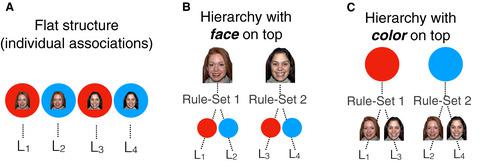Our official English website, www.x-mol.net, welcomes your feedback! (Note: you will need to create a separate account there.)
All contexts are not created equal: Social stimuli win the competition for organizing reinforcement learning in 9-month-old infants
Developmental Science ( IF 4.939 ) Pub Date : 2021-01-23 , DOI: 10.1111/desc.13088 Denise M Werchan 1 , Dima Amso 2
Developmental Science ( IF 4.939 ) Pub Date : 2021-01-23 , DOI: 10.1111/desc.13088 Denise M Werchan 1 , Dima Amso 2
Affiliation

|
Previous work has shown that infants as young as 8 months of age can use certain features of the environment, such as the shape or color of visual stimuli, as cues to organize simple inputs into hierarchical rule structures, a robust form of reinforcement learning that supports generalization of prior learning to new contexts. However, especially in cluttered naturalistic environments, there are an abundance of potential cues that can be used to structure learning into hierarchical rule structures. It is unclear how infants determine what features constitute a higher-order context to organize inputs into hierarchical rule structures. Here, we examine whether 9-month-old infants are biased to use social stimuli, relative to non-social stimuli, as a higher-order context to organize learning of simple visuospatial inputs into hierarchical rule sets. Infants were presented with four face/color-target location pairings, which could be learned most simply as individual associations. Alternatively, infants could use the faces or colorful backgrounds as a higher-order context to organize the inputs into simpler color-location or face-location rules, respectively. Infants were then given a generalization test designed to probe how they learned the initial pairings. The results indicated that infants appeared to use the faces as a higher-order context to organize simpler color-location rules, which then supported generalization of learning to new face contexts. These findings provide new evidence that infants are biased to organize reinforcement learning around social stimuli.
中文翻译:

并非所有环境都是平等的:社会刺激赢得了 9 个月大婴儿组织强化学习的竞争
先前的研究表明,年仅 8 个月大的婴儿可以使用环境的某些特征,例如视觉刺激的形状或颜色,作为将简单输入组织成分层规则结构的线索,这是一种强大的强化学习形式,支持将先前的学习推广到新的环境。然而,特别是在杂乱的自然环境中,有大量的潜在线索可用于将学习结构化为分层规则结构。目前尚不清楚婴儿如何确定哪些特征构成高阶上下文以将输入组织成分层规则结构。在这里,我们检查 9 个月大的婴儿是否偏向于使用社会刺激,相对于非社会刺激,作为将简单视觉空间输入的学习组织成分层规则集的高阶上下文。向婴儿展示了四个面部/颜色-目标位置配对,它们可以最简单地作为个体关联来学习。或者,婴儿可以使用面部或彩色背景作为高阶上下文,将输入分别组织成更简单的颜色定位或面部定位规则。然后对婴儿进行旨在探究的泛化测试他们是如何学习最初的配对的。结果表明,婴儿似乎使用面部作为高阶上下文来组织更简单的颜色定位规则,然后支持将学习推广到新的面部上下文。这些发现提供了新的证据,表明婴儿倾向于围绕社会刺激组织强化学习。
更新日期:2021-01-23
中文翻译:

并非所有环境都是平等的:社会刺激赢得了 9 个月大婴儿组织强化学习的竞争
先前的研究表明,年仅 8 个月大的婴儿可以使用环境的某些特征,例如视觉刺激的形状或颜色,作为将简单输入组织成分层规则结构的线索,这是一种强大的强化学习形式,支持将先前的学习推广到新的环境。然而,特别是在杂乱的自然环境中,有大量的潜在线索可用于将学习结构化为分层规则结构。目前尚不清楚婴儿如何确定哪些特征构成高阶上下文以将输入组织成分层规则结构。在这里,我们检查 9 个月大的婴儿是否偏向于使用社会刺激,相对于非社会刺激,作为将简单视觉空间输入的学习组织成分层规则集的高阶上下文。向婴儿展示了四个面部/颜色-目标位置配对,它们可以最简单地作为个体关联来学习。或者,婴儿可以使用面部或彩色背景作为高阶上下文,将输入分别组织成更简单的颜色定位或面部定位规则。然后对婴儿进行旨在探究的泛化测试他们是如何学习最初的配对的。结果表明,婴儿似乎使用面部作为高阶上下文来组织更简单的颜色定位规则,然后支持将学习推广到新的面部上下文。这些发现提供了新的证据,表明婴儿倾向于围绕社会刺激组织强化学习。


























 京公网安备 11010802027423号
京公网安备 11010802027423号